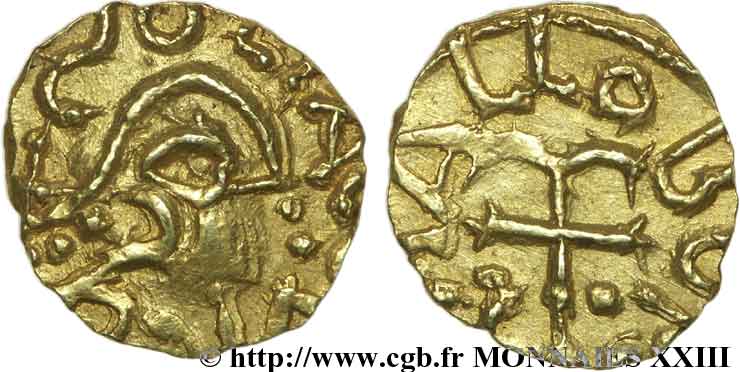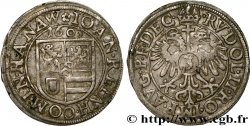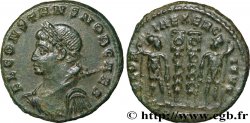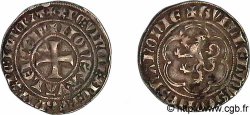v23_0907 - SOUILLE (SOLLIACVS VICUS) - Sarthe, arrondissement du Mans Triens, monétaire MALLEBODVS
MONNAIES 23 (2004)
Precio de inicio : 1 800.00 €
Valoración : 3 200.00 €
Precio realizado : 2 220.00 €
Número de ofertas : 3
Oferta más alta : 3 160.00 €
Precio de inicio : 1 800.00 €
Valoración : 3 200.00 €
Precio realizado : 2 220.00 €
Número de ofertas : 3
Oferta más alta : 3 160.00 €
Tipo : Triens, monétaire MALLEBODVS
Fecha: (VIIe siècle)
Nombre del taller / ciudad: Souille
Metal: oro
Diámetro: 11 mm
Eje de acuñación: 9 h.
Peso: 1,12 g.
Grado de rareza: R3
Comentarios sobre el estado de conservación:
Monnaie bien centrée et complète bien que frappée sur un petit flan. Très légère faiblesse de frappe au revers, sur la partie gauche de la croix
N° en los catálogos de referencia :
Pedigrí:
Cet exemplaire aurait été acheté en avril 1958 à Émile Bourgey et proviendrait, selon lui, de la collection Jarry d’Orléans, vendue en 1878 par Rollin et Feuardent
Anverso
Titulatura del anverso: +SOLIACO VICO.
Descripción del anverso: Buste à droite, se rapprochant du type de l’appendice perlé, légende circulaire.
Reverso
Titulatura del reverso: +MALLOBODS.
Descripción del reverso: Croix ancrée accostée de deux besants et fichée sur un globe.
Comentario
Les lettres du revers se rapprochent de celles de l’exemplaire n° 35 publié par Combrouse et reprise dans la Recherche des monnaies mérovingiennes du Cenomanicum, par Ponton d’Amécourt, 1883, n° 35. Cependant, notre exemplaire a la particularité d’avoir la légende MALLOBODS au lieu de MALLEBODS.
Selon Ponton d'Amécourt, le nom du monétaire "a subi de graves altérations sur les monnaies par suite d'une production d'espèces très actives dont le résultat a été de faire confier la fabrication des coins à des ouvriers illettrés et maladroits". Les monnaies se divisent en trois groupes ; le premier pour le nom de monétaire inscrit au revers, avec la forme MALLEBODVS, et les variantes MALLEBODIS, MALLEBODS et MALLEBODIO. Notre monnaie appartient à ce premier groupe, bien que la légende soit légèrement différente des exemplaires connus, avec un O qui remplace le premier E de MALLEBODS. Cette constatation rejoint la remarque de Ponton d’Amécourt concernant les “ouvriers illettrés et maladroits”. Le second groupe a le nom du monétaire au droit, avec les formes ALEBODVS et ALEBODES (suppression de M). Le troisième a le nom du monétaire replacé au revers avec les formes ALEODVS et ALEVDVS (suppression de M). Le type de buste est très proche du style cénoman de la pièce précédente. Les lettres ICO de la fin de la légende du droit semblent se confondre avec les plis du vêtement et la base du cou.
Moins de dix ans après la publication de Ponton d'Amécourt, le Prou ne reprend qu'une monnaie pour Souillé, cf. PROU n° 469. Il classe en revanche les monnaies SOLIACO VICO à Sully-sur-Loire (Loiret). Une fois de plus, comme en numismatique gauloise, il est difficile de trancher sur une attribution avec exactitude. Cette situation inconfortable ne changera que lorsque les trouvailles seront inventoriées et lorsque les spécialistes diffuseront leurs connaissances.
The letters on the reverse are similar to those of example no. 35 published by Combrouse and included in the Recherche des monnaies mérovingiennes du Cenomanicum, by Ponton d'Amécourt, 1883, no. 35. However, our example has the particularity of having the legend MALLOBODS instead of MALLEBODS.
According to Ponton d'Amécourt, the name of the monetary \\\"has undergone serious alterations on the coins as a result of a very active production of specie, the result of which has been to entrust the manufacture of the dies to illiterate and clumsy workers.\\\". The coins are divided into three groups; the first for the name of the coin inscribed on the reverse, with the form MALLEBODVS, and the variants MALLEBODIS, MALLEBODS and MALLEBODIO. Our coin belongs to this first group, although the legend is slightly different from the known examples, with an O replacing the first E of MALLEBODS. This observation is consistent with Ponton d'Amécourt's remark concerning “illiterate and clumsy workers”. The second group has the name of the monetary right, with the forms ALEBODVS and ALEBODES (deletion of M). The third has the name of the mint replaced on the reverse with the forms ALEODVS and ALEVDVS (deletion of M). The type of bust is very close to the Cenoman style of the previous piece. The letters ICO at the end of the legend of the right seem to merge with the folds of the garment and the base of the neck.
Less than ten years after the publication of Ponton d'Amécourt, the Prou only took one coin for Souillé, cf.. PROU No. 469. On the other hand, he classifies the SOLIACO VICO coins in Sully-sur-Loire (Loiret). Once again, as in Gallic numismatics, it is difficult to decide on an attribution with precision.. This uncomfortable situation will only change when the finds are inventoried and when specialists disseminate their knowledge.
Selon Ponton d'Amécourt, le nom du monétaire "a subi de graves altérations sur les monnaies par suite d'une production d'espèces très actives dont le résultat a été de faire confier la fabrication des coins à des ouvriers illettrés et maladroits". Les monnaies se divisent en trois groupes ; le premier pour le nom de monétaire inscrit au revers, avec la forme MALLEBODVS, et les variantes MALLEBODIS, MALLEBODS et MALLEBODIO. Notre monnaie appartient à ce premier groupe, bien que la légende soit légèrement différente des exemplaires connus, avec un O qui remplace le premier E de MALLEBODS. Cette constatation rejoint la remarque de Ponton d’Amécourt concernant les “ouvriers illettrés et maladroits”. Le second groupe a le nom du monétaire au droit, avec les formes ALEBODVS et ALEBODES (suppression de M). Le troisième a le nom du monétaire replacé au revers avec les formes ALEODVS et ALEVDVS (suppression de M). Le type de buste est très proche du style cénoman de la pièce précédente. Les lettres ICO de la fin de la légende du droit semblent se confondre avec les plis du vêtement et la base du cou.
Moins de dix ans après la publication de Ponton d'Amécourt, le Prou ne reprend qu'une monnaie pour Souillé, cf. PROU n° 469. Il classe en revanche les monnaies SOLIACO VICO à Sully-sur-Loire (Loiret). Une fois de plus, comme en numismatique gauloise, il est difficile de trancher sur une attribution avec exactitude. Cette situation inconfortable ne changera que lorsque les trouvailles seront inventoriées et lorsque les spécialistes diffuseront leurs connaissances.
The letters on the reverse are similar to those of example no. 35 published by Combrouse and included in the Recherche des monnaies mérovingiennes du Cenomanicum, by Ponton d'Amécourt, 1883, no. 35. However, our example has the particularity of having the legend MALLOBODS instead of MALLEBODS.
According to Ponton d'Amécourt, the name of the monetary \\\"has undergone serious alterations on the coins as a result of a very active production of specie, the result of which has been to entrust the manufacture of the dies to illiterate and clumsy workers.\\\". The coins are divided into three groups; the first for the name of the coin inscribed on the reverse, with the form MALLEBODVS, and the variants MALLEBODIS, MALLEBODS and MALLEBODIO. Our coin belongs to this first group, although the legend is slightly different from the known examples, with an O replacing the first E of MALLEBODS. This observation is consistent with Ponton d'Amécourt's remark concerning “illiterate and clumsy workers”. The second group has the name of the monetary right, with the forms ALEBODVS and ALEBODES (deletion of M). The third has the name of the mint replaced on the reverse with the forms ALEODVS and ALEVDVS (deletion of M). The type of bust is very close to the Cenoman style of the previous piece. The letters ICO at the end of the legend of the right seem to merge with the folds of the garment and the base of the neck.
Less than ten years after the publication of Ponton d'Amécourt, the Prou only took one coin for Souillé, cf.. PROU No. 469. On the other hand, he classifies the SOLIACO VICO coins in Sully-sur-Loire (Loiret). Once again, as in Gallic numismatics, it is difficult to decide on an attribution with precision.. This uncomfortable situation will only change when the finds are inventoried and when specialists disseminate their knowledge.








 Informar de un error
Informar de un error Imprimir la página
Imprimir la página Comparte mi selección
Comparte mi selección Haz una pregunta
Haz una pregunta Consignar / vender
Consignar / vender










